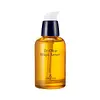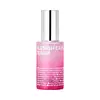What's inside
What's inside
 Key Ingredients
Key Ingredients

 Benefits
Benefits

 Concerns
Concerns

 Ingredients Side-by-side
Ingredients Side-by-side

Water
Skin ConditioningButylene Glycol
HumectantLoess Extract
Skin ConditioningSodium Hyaluronate
HumectantAlcohol
Antimicrobial1,2-Hexanediol
Skin ConditioningPEG/PPG-18/4 Copolymer
SolventMethyl Gluceth-20
HumectantHydrolyzed Collagen
EmollientArginine
MaskingCarbomer
Emulsion StabilisingSophora Flavescens Root Extract
AntioxidantHouttuynia Cordata Extract
Skin ConditioningMorus Alba Bark Extract
Skin ConditioningGlycerin
HumectantGlyceryl Acrylate/Acrylic Acid Copolymer
HumectantPropylene Glycol
HumectantPvm/Ma Copolymer
Emulsion StabilisingAloe Barbadensis Leaf Extract
EmollientCitrus Medica Limonum Fruit Water
Skin ConditioningNelumbo Nucifera Seed Extract
AntimicrobialChrysanthemum Indicum Flower Extract
Skin ConditioningPaullinia Cupana Seed Extract
Skin ConditioningEuterpe Oleracea Fruit Extract
Allantoin
Skin ConditioningPanthenol
Skin ConditioningBetaine
HumectantPEG-60 Hydrogenated Castor Oil
EmulsifyingMyrciaria Dubia Fruit Extract
Skin ConditioningDisodium EDTA
Camellia Sinensis Leaf Extract
AntimicrobialMelaleuca Alternifolia Leaf Extract
PerfumingThymus Vulgaris Extract
PerfumingEcklonia Cava Extract
Skin ConditioningHyssopus Officinalis Extract
MaskingBuddleja Davidii Extract
Skin ConditioningMalva Sylvestris Flower Extract
Skin ConditioningAloe Vera Callus Extract
AntioxidantPhaseolus Radiatus Seed Extract
Skin ConditioningEthylhexylglycerin
Skin ConditioningParfum
MaskingCI 19140
Cosmetic ColorantWater, Butylene Glycol, Loess Extract, Sodium Hyaluronate, Alcohol, 1,2-Hexanediol, PEG/PPG-18/4 Copolymer, Methyl Gluceth-20, Hydrolyzed Collagen, Arginine, Carbomer, Sophora Flavescens Root Extract, Houttuynia Cordata Extract, Morus Alba Bark Extract, Glycerin, Glyceryl Acrylate/Acrylic Acid Copolymer, Propylene Glycol, Pvm/Ma Copolymer, Aloe Barbadensis Leaf Extract, Citrus Medica Limonum Fruit Water, Nelumbo Nucifera Seed Extract, Chrysanthemum Indicum Flower Extract, Paullinia Cupana Seed Extract, Euterpe Oleracea Fruit Extract, Allantoin, Panthenol, Betaine, PEG-60 Hydrogenated Castor Oil, Myrciaria Dubia Fruit Extract, Disodium EDTA, Camellia Sinensis Leaf Extract, Melaleuca Alternifolia Leaf Extract, Thymus Vulgaris Extract, Ecklonia Cava Extract, Hyssopus Officinalis Extract, Buddleja Davidii Extract, Malva Sylvestris Flower Extract, Aloe Vera Callus Extract, Phaseolus Radiatus Seed Extract, Ethylhexylglycerin, Parfum, CI 19140
Water
Skin ConditioningRosa Damascena Flower Water
MaskingGlycerin
HumectantAlcohol
AntimicrobialBetaine
HumectantArbutin
AntioxidantTrehalose
HumectantRosa Damascena Flower Oil
MaskingArctostaphylos Uva-Ursi Leaf Extract
Skin ConditioningRhodiola Rosea Root Extract
EmollientHippophae Rhamnoides Fruit Extract
Skin ConditioningEuterpe Oleracea Fruit Extract
Vaccinium Angustifolium Fruit Extract
Skin ProtectingPhyllanthus Emblica Fruit Extract
HumectantVaccinium Macrocarpon Fruit Extract
AstringentSophora Flavescens Root Extract
AntioxidantHouttuynia Cordata Extract
Skin ConditioningXanthan Gum
EmulsifyingAllantoin
Skin ConditioningPanthenol
Skin ConditioningAdansonia Digitata Leaf Extract
Skin ConditioningCastanea Crenata Shell Extract
Skin ConditioningSalix Alba Bark Extract
AstringentCentella Asiatica Extract
CleansingButylene Glycol
Humectant1,2-Hexanediol
Skin ConditioningCalendula Officinalis Flower Extract
MaskingScutellaria Baicalensis Root Extract
AstringentPaeonia Suffruticosa Root Extract
Skin ProtectingGlycyrrhiza Glabra Root Extract
BleachingCitronellol
PerfumingGeraniol
PerfumingWater, Rosa Damascena Flower Water, Glycerin, Alcohol, Betaine, Arbutin, Trehalose, Rosa Damascena Flower Oil, Arctostaphylos Uva-Ursi Leaf Extract, Rhodiola Rosea Root Extract, Hippophae Rhamnoides Fruit Extract, Euterpe Oleracea Fruit Extract, Vaccinium Angustifolium Fruit Extract, Phyllanthus Emblica Fruit Extract, Vaccinium Macrocarpon Fruit Extract, Sophora Flavescens Root Extract, Houttuynia Cordata Extract, Xanthan Gum, Allantoin, Panthenol, Adansonia Digitata Leaf Extract, Castanea Crenata Shell Extract, Salix Alba Bark Extract, Centella Asiatica Extract, Butylene Glycol, 1,2-Hexanediol, Calendula Officinalis Flower Extract, Scutellaria Baicalensis Root Extract, Paeonia Suffruticosa Root Extract, Glycyrrhiza Glabra Root Extract, Citronellol, Geraniol
Ingredients Explained
These ingredients are found in both products.
Ingredients higher up in an ingredient list are typically present in a larger amount.
1,2-Hexanediol is a synthetic liquid and another multi-functional powerhouse.
It is a:
- Humectant, drawing moisture into the skin
- Emollient, helping to soften skin
- Solvent, dispersing and stabilizing formulas
- Preservative booster, enhancing the antimicrobial activity of other preservatives
Alcohol comes in many different forms. Different types of alcohol will have different effects on skin. This ingredient is usually an astringent alcohol.
These alcohols are drying on the skin. They may strip away your skin's natural oils and even damage your skin barrier. Astringent alcohols may also irritate skin.
Other types of astringent alcohols include:
According to the National Rosacea Society based in the US, you should be mindful of products with these alcohols in the top half of ingredients.
Any type of sanitizing product will have high amounts of alcohol to help kill bacteria and viruses.
Fatty alcohols come from plant oils such as coconut oil. These can help hydrate the skin and are non-irritating. Some fatty alcohols include cetyl and stearyl alcohol.
Learn more about AlcoholAllantoin is a soothing ingredient known for its protective and moisturizingg properties. Because of this, it is often added to products with strong active ingredients.
Studies show higher concentrations of this ingredient can promote wound healing.
Though it can be derived from the comfrey plant, allantoin is produced synthetically for cosmetic products to ensure purity.
Learn more about AllantoinBetaine is a common humectant (a substance that promotes retention of moisture). It's known to be gentle on the skin and can help balance hydration.
This ingredient is best for improving hydration and soothing irritated skin. Studies also show it helps even out skin tone.
Fun fact: Betaine is naturally created in the skin and body. The kind found within cosmetic products can be either plant-derived or synthetic.
Another name for betaine is trimethylglycine.
Learn more about BetaineButylene Glycol (or BG) is used within cosmetic products for a few different reasons:
Overall, Butylene Glycol is a safe and well-rounded ingredient that works well with other ingredients.
Though this ingredient works well with most skin types, some people with sensitive skin may experience a reaction such as allergic rashes, closed comedones, or itchiness.
Learn more about Butylene GlycolThis extract comes from the Cabbage Palm, AKA the Açaí berry! It has skin soothing, antioxidant, and anti-aging properties.
Acai berries are rich in antioxidants, including ferulic acid (The famous vitamin C stabilizer). Antioxidants protect your skin against damaging free-radical molecules.
You can also find carbohydrates, lipids, proteins, minerals, vitamin A, and Vitamin C in these berries.
Learn more about Euterpe Oleracea Fruit ExtractGlycerin is already naturally found in your skin. It helps moisturize and protect your skin.
A study from 2016 found glycerin to be more effective as a humectant than AHAs and hyaluronic acid.
As a humectant, it helps the skin stay hydrated by pulling moisture to your skin. The low molecular weight of glycerin allows it to pull moisture into the deeper layers of your skin.
Hydrated skin improves your skin barrier; Your skin barrier helps protect against irritants and bacteria.
Glycerin has also been found to have antimicrobial and antiviral properties. Due to these properties, glycerin is often used in wound and burn treatments.
In cosmetics, glycerin is usually derived from plants such as soybean or palm. However, it can also be sourced from animals, such as tallow or animal fat.
This ingredient is organic, colorless, odorless, and non-toxic.
Glycerin is the name for this ingredient in American English. British English uses Glycerol/Glycerine.
Learn more about GlycerinHouttuynia Cordata Extract is more commonly known as Heart Leaf, Fish Mint, or Chameleon plant.
The components found in Heart Leaf give it antioxidant, hydrating, antimicrobial, and anti-inflammatory properties.
Heart Leaf is rich in flavonoids such as quercetin, apigenin, and more. It also contains polysaccharides, the most common type of carbs in food.
Flavonoids have been shown to be effective antioxidants. They help neutralize free-radical molecules. Free-radical molecules are unstable molecules that may damage our skin cells and DNA. The flavonoids in Heart Leaf also help soothe the skin.
Polysaccharides are naturally found in our skin. They play a role in hydrating and repairing the top layer of skin. The polysaccharides in Heart Leaf help moisturize our skin.
Studies show decanoyl acetaldehyde, a component of Heart Leaf oil, is effective at killing bacteria.
The name 'Fish Mint' comes from the herb's natural fishy smell. Is is native to southeast Asia and used throughout the continent for traditional cooking and medicine.
Learn more about Houttuynia Cordata ExtractPanthenol is a common ingredient that helps hydrate and soothe the skin. It is found naturally in our skin and hair.
There are two forms of panthenol: D and L.
D-panthenol is also known as dexpanthenol. Most cosmetics use dexpanthenol or a mixture of D and L-panthenol.
Panthenol is famous due to its ability to go deeper into the skin's layers. Using this ingredient has numerous pros (and no cons):
Like hyaluronic acid, panthenol is a humectant. Humectants are able to bind and hold large amounts of water to keep skin hydrated.
This ingredient works well for wound healing. It works by increasing tissue in the wound and helps close open wounds.
Once oxidized, panthenol converts to pantothenic acid. Panthothenic acid is found in all living cells.
This ingredient is also referred to as pro-vitamin B5.
Learn more about PanthenolSophora Flavescens Root Extract is an antioxidant.
Water. It's the most common cosmetic ingredient of all. You'll usually see it at the top of ingredient lists, meaning that it makes up the largest part of the product.
So why is it so popular? Water most often acts as a solvent - this means that it helps dissolve other ingredients into the formulation.
You'll also recognize water as that liquid we all need to stay alive. If you see this, drink a glass of water. Stay hydrated!
Learn more about Water